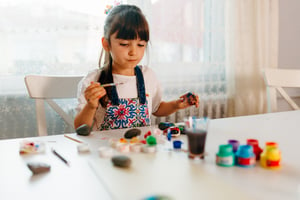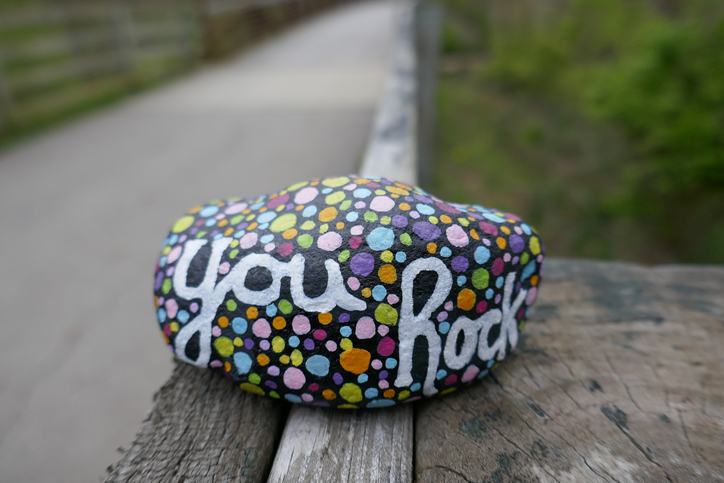Teaching Kindness: The Kindness Rock Project
How to Teach Your Autistic Child the Art of Caring and Kindness
Teaching caring and kindness to autistic children is an important part of social-emotional development. Having empathy and kindness towards others improves the quality of everyone's life. It also allows us to understand how others are feeling and develop greater empathy for others. This helps us better understand how to respond appropriately when others are in need. These important social skills allow children to connect socially and emotionally with others and develop stronger relationships and friendships.
 Being kind isn’t just nice for others, it has personal health benefits. In 2018, a meta-analysis collected data from 27 experimental studies relating to kindness and happiness. Through analysis of all the results, researchers found that on average, carrying out acts of kindness increases well-being, life satisfaction, happiness, and a positive outlook on life. Random acts of kindness are a lovely way to remind others that they are loved, valued, and important.
Being kind isn’t just nice for others, it has personal health benefits. In 2018, a meta-analysis collected data from 27 experimental studies relating to kindness and happiness. Through analysis of all the results, researchers found that on average, carrying out acts of kindness increases well-being, life satisfaction, happiness, and a positive outlook on life. Random acts of kindness are a lovely way to remind others that they are loved, valued, and important.
Megan Murphy created the “Kindness Rocks Project” in Cape Cod, Massachusetts. After the loss of her parents, she realized how meaningful small acts of kindness were during that difficult period in her life. Murphy began to paint “kindness rocks” and spread them throughout her community. The rocks were colorfully painted, with uplifting words on them. She scattered the rocks anonymously for one year, until sharing her project publicly. The mission of the Kindness Rock Project is: “ONE MESSAGE AT JUST THE RIGHT MOMENT CAN CHANGE SOMEONE’S ENTIRE DAY, OUTLOOK, LIFE.”
The Kindness Rock Project is a wonderful way to connect with your community in any setting or circumstance. Here’s how you can make Kindness Rocks:
-
The size, shape, and color doesn't matter. You can find rocks around your neighborhood or order painting rocks from local craft stores. Collect rocks.
Collect rocks. -
Pick out your paints.
The more colorful, the better! You want your kindness rocks to stick out among plain rocks so those walking by notice them. -
Choose a kind message.
The goal of Murphy’s Kindness Rock Project was to spread messages of kindness and caring on rocks. Depending on the size of the rock, you can write a longer message, like “Everyone Matters,” or a shorter message, like “Peace.” If you don’t want to write a message, a beautiful illustration of sunshine or a flower will spread positivity. -
Decorate your Kindness Rocks.
Make your message last. Weather can make the paint on your rocks wear off over time. You can seal them with a clear matte aerosol available at local craft stores.
 There are other ways you can spread kindness and positivity in your community. Here are some additional ideas that your child and the whole family can participate in:
There are other ways you can spread kindness and positivity in your community. Here are some additional ideas that your child and the whole family can participate in:
-
Leave letters in neighbor’s mailboxes.
These can be messages of kindness, like “We are thinking of you and hope you are doing well!” -
Send a virtual message.
Leaving an uplifting voicemail or texting a video to a friend or family member is a nice keepsake for them to look back on. -
Dance party!
This can be done virtually. Cue up some music, share a Zoom link, and dance all afternoon, laughing along with others. -
Send members in your community an uplifting message.
First responders, essential employees, postal carriers, and delivery drivers all work very hard to serve the community. Grab a poster board and some markers and create a colorful message to hang in a doorway or window to remind them all that they're appreciated. You can also leave a note of appreciation in your mailbox for the postal carriers, or tape one to your door for delivery drivers. -
Decorate your space.
Spread some color and light and plant some flowers or put lights up around the house! It will brighten your space and neighbors passing by will appreciate the festivities.
Incorporating these acts of kindness into your family’s routine is a great way to teach your child ways to show kindness.
Explicitly teaching why kindness is important allows your child to understand the importance of the acts they are doing. Here are some strategies to explain to your child what kindness is:
-
Check-in with feelings.
Understanding how it feels to be kind and how it feels to be treated kindly motivates children to carry out more acts of kindness. When your child acts kindly, ask them how they feel. They may communicate best verbally or with visuals. Being able to identify how good they feel when they are kind helps children to understand the importance of kindness and caring. -
Create a journal.
Reflection is important in developing understanding. When your child acts with caring or kindness, have them journal about it. They may create a drawn, written, or video log to track acts of kindness they’ve done and how it made them - and the receiver - feel. -
Lead by example.
Incorporating acts of kindness and showing caring in our daily lives highlights the importance of it to our children. When you surprise your child with an act of kindness, such as making their favorite food, for example, it helps them understand how the receiver feels.
Simple acts of kindness are a powerful way to show others that you care. Kindness is contagious and may inspire others to do the same. Modeling acts of kindness with your autistic child will help them develop important social-emotional skills while having fun.
This article is based on the following research and information sources:
https://the-art-of-autism.com/spreading-kindness-with-hand-painted-rocks-and-shells/
https://twincitieskidsclub.com/teaching-your-kids-kindness-with-the-kindness-rocks-project/
https://www.thekindnessrocksproject.com
https://the-art-of-autism.com/world-kindness-day-suggestions/
http://www.beautifulmindscenterforautism.com/blog/how-to-teach-your-child-with-autism-to-practice-acts-of-kindness/





